Glorious or sad/bad timing? The death of William Wilberforce… Slavery abolished…
May 25, 2017 by GuyHeilenman · Leave a Comment
 The Gentleman’s Magazine of September, 1773 has a 3+ page obituary of the famed British abolitionist, William Wilberforce. If you are not familiar with this early 18th century member of the British Parliament, you may want to settle in with family and friends and watch the acclaimed movie, Amazing Grace. However, as a primer, feel free to read the complete obituary at: William Wilberforce Death Report. Ironically, you’ll need to scroll past much on the India slave trade in order to view the obituary.
The Gentleman’s Magazine of September, 1773 has a 3+ page obituary of the famed British abolitionist, William Wilberforce. If you are not familiar with this early 18th century member of the British Parliament, you may want to settle in with family and friends and watch the acclaimed movie, Amazing Grace. However, as a primer, feel free to read the complete obituary at: William Wilberforce Death Report. Ironically, you’ll need to scroll past much on the India slave trade in order to view the obituary.
Speaking of irony… The date of his death is sandwiched between the Slavery Abolition Act of 1833’s passage in the House of Commons on July 26, 1833 and its Royal Assent a month later (on August 28th). Whereas the entire obituary can be read through the link above, as of the date of this post, it is also available as an eBay auction at: Wilberforce’s Obit (on eBay).
A political cartoon from 1776 themed on the Revolutionary War…
February 23, 2017 by TimHughes · Leave a Comment
 Political cartoons are ever-present in our world today. It would be difficult to find a daily or weekly publication today without at least one. And they have been around for a long time–perhaps longer than you might think.
Political cartoons are ever-present in our world today. It would be difficult to find a daily or weekly publication today without at least one. And they have been around for a long time–perhaps longer than you might think.
There was the occasional political cartoon in 18th century magazines, only a few of which are American-themed, and fewer still can be found as most have been removed years ago. Although we have had a few in years past, we recently purchased not only a very nice one, but one from a title difficult to find in today’s world of collecting.
The November, 1776 issue of “The London Magazine: Or, Gentleman’s Monthly Intelligencer”, not to be confused with the more common “Gentleman’s Magazine”. A full page plate in the issue has a very political cartoon themed on the Revolutionary War, captioned: “News From America, or the Patriots in the Dumps.” and shows Lord North standing on a platform holding a letter announcing successful campaigns by the British troops in America. A distraught woman, ‘America’, holding a liberty cap, sits at the base of the platform. Others present react to the news. There are several websites concerning this political cartoon, one of which can be seen here.
They put it in print… the Stamp Act…
August 27, 2015 by GuyHeilenman · Leave a Comment
 Some of the most noteworthy events in history have humble beginnings. Such is the case with the announcing of the passage of The Stamp Act in The Gentleman’s Magazine, March, 1765. Under the Historical Chronicle section is the rather inconspicuous note, “Lord Mansfield, as speaker, and the Earls Gower and Marchmont, by virtue of a commission from his majesty, gave the royal assent to the following bills: …for laying a stamp duty in the British colonies in America.” While this official notification of the Stamp Act most likely flew under the radar of most readers of the day, there is no doubt regarding its significance. I wonder which one-liners which go unnoticed today will prove similar ten years from now?
Some of the most noteworthy events in history have humble beginnings. Such is the case with the announcing of the passage of The Stamp Act in The Gentleman’s Magazine, March, 1765. Under the Historical Chronicle section is the rather inconspicuous note, “Lord Mansfield, as speaker, and the Earls Gower and Marchmont, by virtue of a commission from his majesty, gave the royal assent to the following bills: …for laying a stamp duty in the British colonies in America.” While this official notification of the Stamp Act most likely flew under the radar of most readers of the day, there is no doubt regarding its significance. I wonder which one-liners which go unnoticed today will prove similar ten years from now?
The Traveler… Col. Bradstreet’s peace offering… the devil’s what?…
December 1, 2014 by The Traveler · Leave a Comment
Today I traveled to London, England, by the way of The Gentleman’s Magazine of December, 1764. There I found a letter from Quebec reporting “Col. Bradstreet, on his arrival at 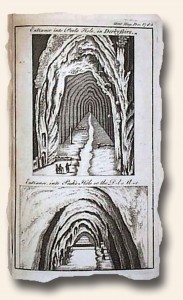 Detroit, sent a belt of peace to General Pontiac, but he, like a true hero, depended on his power, and greatly dared his worst, by cutting the belt in pieces at the head of his army, (the Indians) and two days ago an Indian canoe came on board us, who assured us M. Pontiak had assembled all his forces together at St. Dusky, and received Col. Bradstreet with undaunted courage… “.
Detroit, sent a belt of peace to General Pontiac, but he, like a true hero, depended on his power, and greatly dared his worst, by cutting the belt in pieces at the head of his army, (the Indians) and two days ago an Indian canoe came on board us, who assured us M. Pontiak had assembled all his forces together at St. Dusky, and received Col. Bradstreet with undaunted courage… “.
Also in the issue is a “sketch of Peak’s Hole commonly called the Devil’s A—–se-A-Peak in Derbyshire”. This also is Pool’s Hole and includes a plate with two illustrations. To enter this, “the entrance is by a small arch, so very low, that such a venture into it are forced to creep upon their hands and knees, but it gradually opens into a vault more than a quarter of a mile long, and, as some have pretended, a quarter of a mile high…”. This also has a running stream and both a cold and hot spring — the springs within a hand touch from the other.
~The Traveler
The 1600’s and 1700’s on a budget…
March 25, 2013 by TimHughes · Leave a Comment
A genuine collectible, over 300 years old, for $60 or less. Is there a field of collecting today which has items of such age– in nice condition–for $60? The hobby of collecting rare & historic newspapers likely sits at the top of what must 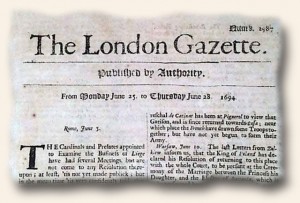 be a very short list. And such prices, along with tremendous availability of titles & content, are part of the intrigue of this fascinating hobby which remains unknown to almost everyone. And this, in large part, is the reason prices are outrageously low in comparison to the relative rarity of other collectibles. While issues do run the gamut price-wise from newsbooks (at the upper end) to coffeehouse newspapers (typically at the lower end), it is a fascinating field for the historical hobbyist on a budget ($20 and under).
be a very short list. And such prices, along with tremendous availability of titles & content, are part of the intrigue of this fascinating hobby which remains unknown to almost everyone. And this, in large part, is the reason prices are outrageously low in comparison to the relative rarity of other collectibles. While issues do run the gamut price-wise from newsbooks (at the upper end) to coffeehouse newspapers (typically at the lower end), it is a fascinating field for the historical hobbyist on a budget ($20 and under).
The ‘London Gazette‘ is the world’s oldest continually published newspaper, having begun in 1665 and is still publishing today. With such historical depth you would expect to find virtually every major event in world history within its pages, and you would be right. The Great Plague and Great London Fire, William Penn being granted land in the New World, the death of noted pirate Captain Kidd, the battles of the French & Indian War and Revolutionary War and so much more are found in not only this title but other newspapers of the era. First reports of such notable events can sell in the thousands of dollars, but an interesting facet of this hobby is that follow-up reports of a few days later can fall well within the comfort level of the average collector.
Both age and graphic appeal come together in the London ‘Post-Boy‘ newspaper, with issues from the 1718-1725 period featuring two ornate engravings in the masthead in addition to a very decorative first letter of the text. Add to this the relative small size of this single sheet newspaper and you have a terrific item for display for under $55.
With American newspapers not beginning until the first decade of the 18th century (one title was published in 1690 but lasted just one day), and most American newspapers through the Revolutionary War being very rare, British titles are an excellent source for collecting all the notable events not only in American history, but in world history as well. And the reporting was often extensive, for remember that the colonies were part of Great Britain through 1776.
The ‘London Chronicle’ was a popular British newspaper which documented amongst its pages virtually all American events since its founding during the French & Indian War. Yet another periodical, the ‘Gentleman’s Magazine‘, is an 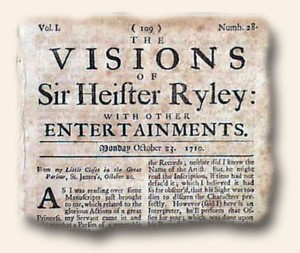 excellent source for period reports of American events since its beginning in 1731, and one of its features was the printing of maps of all corners of the globe, many of which show North America and specific colonies. From James Oglethorpe’s settling the colony of Georgia, to Ben Franklin‘s famous kite experiment, installation of the Liberty Bell, the enactment & repeal of the hated Stamp Act, all events of the Revolutionary War, to the mutiny on the Bounty & so much more, the ‘Gentleman’s Magazine’ offers a terrific repository of American and world history at very affordable prices. Plus, there are reports of Colonel George Washington from 1754 when he was just 22 years old and relatively unknown, and for the music buffs there are works by the composers Hayden, Handel, and death reports of Mozart and Beethoven within its pages. The early battles of Napoleon & other European reports are logically found in this title as well.
excellent source for period reports of American events since its beginning in 1731, and one of its features was the printing of maps of all corners of the globe, many of which show North America and specific colonies. From James Oglethorpe’s settling the colony of Georgia, to Ben Franklin‘s famous kite experiment, installation of the Liberty Bell, the enactment & repeal of the hated Stamp Act, all events of the Revolutionary War, to the mutiny on the Bounty & so much more, the ‘Gentleman’s Magazine’ offers a terrific repository of American and world history at very affordable prices. Plus, there are reports of Colonel George Washington from 1754 when he was just 22 years old and relatively unknown, and for the music buffs there are works by the composers Hayden, Handel, and death reports of Mozart and Beethoven within its pages. The early battles of Napoleon & other European reports are logically found in this title as well.
While American newspapers of the Revolutionary War and before are generally pricey, ranging in the $400 – $1000+ range, two notable exceptions exist being the ‘Boston Chronicle’ and the ‘Pennsylvania Chronicle’, both from the 1768-1769 years. Because their circulation was widespread they are among the more commonly held colonial titles by institutions, & consequently come on the market when libraries convert from hard copy to microfilm or digital. They detail the entire spectrum of American life from just before the Revolutionary War while providing an interesting perspective on American politics during those critical years. Complete, genuine issues are typically available for under $200.
American newspapers from after the American Revolution become more available and at dramatically lower prices while still containing a wealth of notable content on the founding years of the federal government. The ‘Pennsylvania Packet’ of Philadelphia was one of the more successful titles, and was the very first to print the Constitution of the United States. While that issue, September 19, 1787, ranks well into six figures,  dates surrounding it are typically found in the $45 – $80 range and offer a perspective of life in the city where and when the Constitution was being created. The ‘Columbian Centinel’ from Boston was perhaps the most successful title in 18th century America and its pages document the complete scope of America politics and life from 1785 thru Washington’s election and inauguration to his death just weeks before the end of the century.
dates surrounding it are typically found in the $45 – $80 range and offer a perspective of life in the city where and when the Constitution was being created. The ‘Columbian Centinel’ from Boston was perhaps the most successful title in 18th century America and its pages document the complete scope of America politics and life from 1785 thru Washington’s election and inauguration to his death just weeks before the end of the century.
Other 18th century American titles which are within the budgets of even the most modest collectors are the ‘Connecticut Courant’, ‘Dunlap’s American Daily Advertiser’, ‘Gazette of the United States’, the ‘Massachusetts Spy’, and ‘The Herald, A Gazette For The Country’ and others. Nice issues from the formative years of the federal government can be had for under $50 each.
While first reports of the most historic events of the 17th and 18th centuries will always command top dollar among the most savvy of collectors, the hobby of collecting rare newspapers offers a tremendous wealth of issues at surprisingly low prices, while at the same time offering fascinating content on life only known to others through history books. And this hobby is one that offers the entire spectrum of political, economic, and social history to every collector. What other hobby can make that claim? But perhaps most importantly, this hobby let’s you hold—quite literally—history in your hands.
Mormon history in newspapers…
March 15, 2013 by TimHughes · 3 Comments
As is true with any historical event or founding of an institution, collectors of historical newspapers strive for the earliest reports possible. The Declaration of Independence first appeared in a newspaper on July 6, 1776, and that issue commands a six figure price much higher than printings of the document in other newspapers of later dates 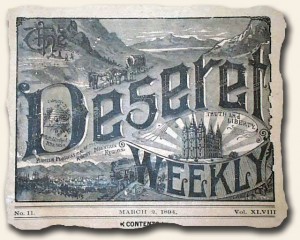 (such as the British Gentleman’s Magazine from August, 1776). Battle reports from the Revolutionary War are most coveted when in newspapers dated as close to the battle as possible. With the widespread use of the telegraph just before the Civil War, timeliness became less of an issue, as events would typically be found in the next day’s edition of newspapers regardless of how distance the printing press was from the event.
(such as the British Gentleman’s Magazine from August, 1776). Battle reports from the Revolutionary War are most coveted when in newspapers dated as close to the battle as possible. With the widespread use of the telegraph just before the Civil War, timeliness became less of an issue, as events would typically be found in the next day’s edition of newspapers regardless of how distance the printing press was from the event.
With institutions, societies & organizations the collector strives for the earliest reports on their creation. Reports from the Continental Congress, the Constitutional Convention, the creation of military academy at West Point, the first baseball game mention, are just a few examples of icons of present-day societies which collectors like to find in newspaper reports dated as early as possible.
Such is true with development of the Church of Jesus Christ of Latter-Day Saints, or the Mormons. Formally organized in upstate New York in 1829 accounts from that year or 1830 would rank among the most desired. Our earliest account was found in the ‘Christian Intelligencer” issue of February 4, 1831. As was typical with reporting of the day, bias, discrimination and prejudice were rampant within the newspaper pages, with the publisher’s mind-set not encumbered by political correctness. This early report notes that: “…the career of some fanatical individuals, who pretend to work miracles and to preach a new gospel. They profess to have discovered somewhere in New York a new revelation, hidden under a stone, which enables them to work miracles…a delusion and phrenzy with which these individual have wrought up the public mind…something like 500 adherents who follow those ignorant and deluded men with the same submission that sheep are led to slaughter…”. This intriguing report was likely the first its subscribers learned of this new religious movement,and with a current membership of over 14 million, this report dates to when just 500 were followers.
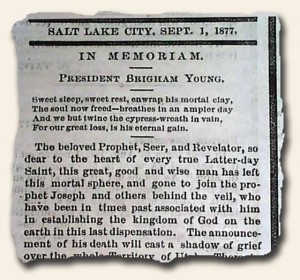 A slightly later report in the popular ‘Niles’ Weekly Register‘ newspaper from Baltimore, July 16, 1831, shows a similar bias & prejudice: “…that certain knaves, pretending to have found some holy writings hidden under a stone…started a new religion! The leaders make bold pretensions and assert a gift to work miracles…now said to amount to 1,000 souls…some of whom…no doubt believe in all things that are told them…” and more.
A slightly later report in the popular ‘Niles’ Weekly Register‘ newspaper from Baltimore, July 16, 1831, shows a similar bias & prejudice: “…that certain knaves, pretending to have found some holy writings hidden under a stone…started a new religion! The leaders make bold pretensions and assert a gift to work miracles…now said to amount to 1,000 souls…some of whom…no doubt believe in all things that are told them…” and more.
Newspaper accounts found in the 1831-1835 period were very few and remain among the most desired among collectors.
By the time the leader Joseph Smith and the Mormons moved from Kirtland, Ohio, to Missouri and then Nauvoo, Illinois by 1839, reports in newspapers became more numerous, as their travels were often made dangerous by the suspicious locals who didn’t want them in their vicinity.
An interesting and desired collection of Mormon-related newspapers would include period reports of their movement westward, from New York to Ohio to Missouri to Illinois and ultimately to their own state of “Deseret” in the present-day state of Utah. With their arrival in 1847, Utah was not only not a state, it was not even a territorial possession. It was part of Mexico, but with the Treaty of Guadalupe Hidalgo which ended the Mexican War in 1848, it became a territory of the United States, and the disputes between the Mormons and the federal government would be legendary, the Mountain Meadows Massacre being among the most publicized. In additional to federal battles, disputes within their organization were quick to make the newspapers, and the practice of plural marriage did not set well with the typical Judeo-Christian ethic of the day.
 Typical of religious movements of the 19th century, the Mormons published several of their own periodicals, among the earliest and occasionally available being ‘Times & Seasons’ done during their turbulent stay in Nauvoo, Illinois. Within its pages was the report of the killing of founder and leader Joseph Smith. Other titles which occasionally surface for collectors are ‘The Latter-Day Saints’ ‘Millennial Star‘, the ‘Gospel Reflector’, and some three years after their arrival at Salt Lake City they set up the ‘Deseret News‘ in 1850, which was the first first newspaper to be published in present-day Utah, some 46 years before it would become a state.
Typical of religious movements of the 19th century, the Mormons published several of their own periodicals, among the earliest and occasionally available being ‘Times & Seasons’ done during their turbulent stay in Nauvoo, Illinois. Within its pages was the report of the killing of founder and leader Joseph Smith. Other titles which occasionally surface for collectors are ‘The Latter-Day Saints’ ‘Millennial Star‘, the ‘Gospel Reflector’, and some three years after their arrival at Salt Lake City they set up the ‘Deseret News‘ in 1850, which was the first first newspaper to be published in present-day Utah, some 46 years before it would become a state.
The fascinating and troublesome history of the Mormons and their trek across the frontier of America is now part & parcel of American history. Finding reports in newspapers from when they happened makes for an interesting segment of any rare newspaper collection.
A cynical view on the Constitutional Convention…
December 3, 2011 by TimHughes · Leave a Comment
Perhaps it would not be a surprise that a British report on the beginning of the American Constitutional Convention would have a cynical slant, but this report seems to stretch the point. This observation appeared in the London “Gentleman’s Magazine” issue of July, 1787.
First use of the term “Columbia”…
December 6, 2010 by TimHughes · Leave a Comment
Finding “first” mentions of significant, people, places and terms is always a delight for the rare newspaper collector, and with the internet–and the time required–many fascinating items can be found.
The term “Columbia” as a reference to America, very commonly used through the 19th century in both print & image, was first used in the London publication “Gentleman’s Magazine” in 1738. Because the printing of Parliamentary debates was illegal in England, they appeared under the thinly veiled heading of “Debates in the Senate of Lilliput” or similar heading, with names & places often fictitious or taken from Johnathan Swift’s famous work, which was the literary sensation at that time. The term Columbia was coined by the famed Samuel Johnson, a regular contributor to the “parliamentary” reports found in “The Gentleman’s Magazine“.
In the June issue of 1738, the debates from Parliament note: “…It is observable that their conquests and acquisitions in Columbia (which is the Lilliputian name for the country that answers our America,) have very little contributed to the power of those nations…”.
A significant “first use” of a very popular poetic name for the United States of America.
One never knows what will be found…
June 7, 2010 by TimHughes · 4 Comments
I suspect I have reflected several times upon the great wealth of interesting information which can be found in a seemingly “generic” issue. Recently I came across an item which was unfound for over 30 years until time permitted a closer look.
I have always touted the value of London’s “Gentleman’s Magazine” as a great periodical, as few world events of the 18th century escaped its pages, including American events from after the Revolutionary War. As a title which has always be somewhat common in a relative sense, when American titles of the 18th century have become almost impossible to find, key issues in “Gentleman’s Magazine” offer an excellent opportunity to add period, historic reports to a collection at a relatively modest cost.
 Admittedly, volumes of this title have become more difficult to come by in recent years, prompting us to take a closer look at some issues which used to go out the door almost as quickly as they came in. The June, 1790 issue was seemingly just another innocuous magazine from the post-war era, and which I suspect we sold dozens of times for $15 to $25 or so. But a week ago I took a more careful look and found an excellent obituary of Benjamin Franklin, taking over 1 1/2 pages, even including is very famous self-written obituary which includes: “The body of Benjamin Franklin, Printer, like the cover of an old book, its content torn out & stript of its lettering & gilding, lies here food for worms…”.
Admittedly, volumes of this title have become more difficult to come by in recent years, prompting us to take a closer look at some issues which used to go out the door almost as quickly as they came in. The June, 1790 issue was seemingly just another innocuous magazine from the post-war era, and which I suspect we sold dozens of times for $15 to $25 or so. But a week ago I took a more careful look and found an excellent obituary of Benjamin Franklin, taking over 1 1/2 pages, even including is very famous self-written obituary which includes: “The body of Benjamin Franklin, Printer, like the cover of an old book, its content torn out & stript of its lettering & gilding, lies here food for worms…”.
You may have purchased this June, 1790 issue from us in years past. If you have, take a look at pages 571-3 and elevate the status of this issue from generic to significant. Even with this wonderful content, we still offer this issue for less than 1/3 the price of comparable reports in American newspapers.
I wonder how many other significant issues we’ve sold over the past 34 years not fully knowing what was inside? Hopefully you have discovered some gems which escaped my eye….it’s all part of the thrill of collecting!
18th century & pre-18th century newspapers… revisited…
December 17, 2009 by GuyHeilenman · Leave a Comment
Over the past two weeks Timothy Hughes has explored his thoughts on what he believes to be the top ten pre-18th century and the top ten 18th century newspapers (see below). Some of these thoughts were captured in the following video:
Collecting authentic rare and historic newspapers from the 1500’s – 1700’s can be exciting, rewarding and surprisingly affordable. British titles such as the London Gazette, London Chronicle, Gentleman’s Magazine and more, are all available for much less than you would expect, as are their American counterparts, the Columbian Centinel, Dunlap’s Daily American Advertiser, Concord Herald, and more.
Whether your interest is in the Colonial Era or the Revolutionary War Era, or extends to the 1500’s and/or 1600’s, original newspapers provide an excellent view of history in context. History is never more fascinating than when when it’s read from the day it was first reported. If you love history… you deserve to have it in your hands. Rare and early historic newspapers make this possible. Please enjoy the hobby!
Top ten newspapers: 16th and 17th centuries…
Top ten newspapers: 18th century…


